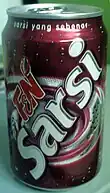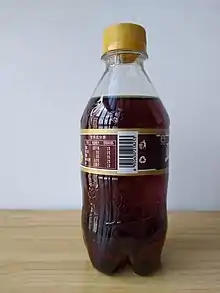
Sarsaparilla (UK: /ˌsɑːrspəˈrɪlə/, US also /ˌsæspəˈrɪlə/ sas-pə-RIL-ə)[1] is a soft drink originally made from the vine Smilax ornata (also called 'sarsaparilla') or other species of Smilax such as Smilax officinalis.[2] In most Southeast Asian countries, it is known by the common name sarsi, and the trademarks Sarsi and Sarsae. It is similar in flavor to root beer. In the US, sarsaparilla is traditionally made with birch oil rather than the tropical plant.
Etymology
Smilax ornata, a perennial trailing vine with prickly stems that is native to Mexico and Central America, is often used as the basis for the soft drink sarsaparilla.[3] Common names include sarsaparilla,[4] Honduran sarsaparilla,[5] and Jamaican sarsaparilla.[6]
It is known in Spanish as zarzaparrilla, which is derived from the words zarza meaning "bramble" (from preroman sarza), and parrilla, meaning "little grape vine".[7][8][9][10][11]
History
Sarsaparilla was popular in the United States in the 19th century. According to advertisements for patent medicines of the period, it was considered to be a remedy for skin and blood problems.[12][13] The Oxford Companion to American Food and Drink notes that it evokes images of "languid belles and parched cowboys".[14]
Sarsaparilla is sometimes considered to be a type of root beer. Dozens of brands of sarsaparilla are made by microbreweries, mainly in the United States.[15]
Availability
Sarsaparilla is not readily available in most countries; however, many pubs and most major supermarket chains in the Philippines, Taiwan, Singapore and Australia stock sarsaparilla-flavored soft drinks, and sarsaparilla remains available in the United Kingdom as a legacy of the temperance movement.[16] Australian sarsaparilla, produced by major manufacturers such as Bundaberg Brewed Drinks, has a flavor very similar, although stronger to, that of American root beer or sarsaparilla.
Sarsi is a sarsaparilla-based drink popular in Asia.
United Kingdom
Sarsaparilla is produced on a small scale in the United Kingdom. Baldwin's has produced a sarsaparilla cordial continuously since 1844. It is produced in Walworth Road, London, and it is readily available in pie and mash shops in the East End of London, where it is popular, as well as being available in many supermarkets, typically in the world foods section. In the North of England sarsaparilla is produced by Fitzpatrick's, Britain's last temperance bar, reflecting its former importance to the temperance movement there. Maine Soft Drinks, based in Northern Ireland, also produce the drink. American soldiers stationed in Northern Ireland during World War Two are said to be responsible for the drink's popularity.
United States
_-_8558173634.jpg.webp)
The classic sarsaparilla was not made from the extract of the sarsaparilla plant, a tropical vine distantly related to the lily. It was originally made from a blend of birch oil and sassafras, the dried root bark of the sassafras tree. In this context, sassafras should not be confused with common sassafras seasoning, filé, used in Cajun cooking and made from dried and ground sassafras leaves. Sassafras was widely used as a home remedy in the 19th century; taken in sufficient doses it induces sweating, which some people thought had health benefits. Sarsaparilla made its debut as a patent medicine, an easy-to-take form of sassafras, much as Coca-Cola was first marketed in 1885 as a remedy for hangovers, headaches and morphine addiction.[17] Besides the effects of the ingredients, sodas were popular in the United States at the time, due to the belief that carbonated water had health benefits.[18] In 1960 the FDA banned the use of sassafras oil in foodstuffs after evidence accumulated showing that the main constituent, safrole, was carcinogenic.[19] Safrole is also found in filé, nutmeg, mace, cinnamon, anise, black pepper and sweet basil, but in low enough concentration to be deemed safe.[20][21]
East Asia
Hong Kong
Watson's Sarsae (Chinese: 屈臣氏沙示汽水) is manufactured and distributed by A.S. Watson Group (HK) Limited. It sold in Park 'n Shop supermarkets and some stores.
Taiwan
HeySong Sarsaparilla (Chinese: 黑松沙士) is the most popular brand of sarsaparilla drink in Taiwan. It is manufactured by HeySong Corporation.[22]
It is available in two varieties:
- Regular – regular sarsaparilla flavor.
- Salted – significantly saltier with a bitter aftertaste.
Southeast Asia
Cambodia
In Cambodia, sarsaparilla is one of the flavors sold under the Fanta brand, bottled and distributed by Cambodia Beverage Company Ltd., a unit of the Coca-Cola SABCO Group.[23]
Indonesia
There are two well known sarsaparilla brands in Indonesia, Badak (from North Sumatra) and Indo Saparella (from the Special Region of Yogyakarta). Badak was established by a Swiss national named Heinrich Surbeck in 1916 in Pematangsiantar, North Sumatra and Indo Saparella was established in 1960 in Yogyakarta. There's also Agung Ngoro a local soft drink brand who produces traditional sarsaparilla in a glass bottle.[24] Both brands can be found in some local restaurants and stalls or marketplace.
Thailand
Hi-Mark by Green Spot was the domestic sarsaparilla drink in Thailand, but was discontinued in 2000. F&N Sarsi has been produced in Thailand by Sermsuk Public Company Limited since 2018, reviving a brand last sold locally in the 1990s.[25]
Vietnam
In Vietnam, sarsaparilla is one of the flavors (Xá Xị) sold under the Mirinda brand, bottled and distributed by Suntory-PepsiCo Vietnam Beverage (formerly, PepsiCo Vietnam).[26] There is also a sarsi flavored soda (Huong Xá Xị) by Coca-Cola under the Fanta brand.[27] There are two local brands offering their own sarsi drink:
- Sá Xị Chương Dương by Chuong Duong Beverages.
- Wonderfarm Zizy by Interfood Shareholding Company.
Sarsaparilla-flavored sodas are available in the south of Vietnam but much more difficult to find in the north.
South Asia
India
Nannari, also known as "Indian sarsaparilla", is a popular drink in South India and usually served with club soda and lime juice.
Sarsi (brand)

Philippines
In the Philippines, Sarsi is a brand name for a sarsaparilla drink originally manufactured by Cosmos Bottling Corporation, a local company that is now a subsidiary of Coca-Cola Beverages Philippines, Inc.[28] Cosmos Bottling Corporation was established in 1918 as Manila Aerated Water Company.[29] Sarsi was originally branded as Cosmos Sarsaparilla until the 1970s. The unique taste that distinguishes the current version of Sarsi from other sarsaparilla-based soft drinks is attributed to the sugar substitute saccharin, although its "regular" formula contains high-fructose corn syrup or cane sugar.
Singapore
In Singapore, F&N Sarsi (originally branded as Sarsi) is a brand name for a sarsaparilla drink manufactured by the Singaporean company F&N Group (Fraser and Neave). It is unrelated to the brand established in the Philippines.
Sarsae (brand)
Mainland China
In mainland China, the drink's introduction can be traced back to the 1920s, when A. S. Watson began producing its sarsaparilla drink in Shanghai and other Chinese cities. In the 1940s, Li Zhiyang (李智扬), Li Guanling (李冠玲), Huang Youtong (黄油桶), Liang Hanqi (梁汉奇) and Wang Zhensan (王震山) were among eleven people who had worked in Watson's Canton and founded Asian Waters in Guangzhou to continue producing Sarsae there and in other mainland Chinese locations.[30]
Asia Sarsae (亚洲沙示) is now produced by Xiangxue Pharmaceutical.
Hong Kong
In Hong Kong, Sarsae (沙示) is the most popular brand of sarsaparilla drink. It is manufactured and distributed by the A. S. Watson Group, which pioneered in carbonated beverages in Hong Kong.[31] The drink was the central plot device of a 1985 film called It's a Drink, It's a Bomb (starring George Lam, John Sham and Maggie Cheung), about a hand grenade disguised as a Sarsae cola, detonated by releasing its ringpull.[32]
See also
References
- ↑ Jones, Daniel (2011). Roach, Peter; Setter, Jane; Esling, John (eds.). Cambridge English Pronouncing Dictionary (18th ed.). Cambridge University Press. ISBN 978-0-521-15255-6.
- ↑ Fern, Ken (30 July 2021). "Useful Tropical Plants Smilax officinalis". tropical.theferns.info. Tropical Plants Database. Retrieved 20 March 2022.
- ↑ "Plants of the World Online | Kew Science". Plants of the World Online.
- ↑ "Sarsaparilla (soft drink)". Germplasm Resources Information Network. Agricultural Research Service, United States Department of Agriculture. Retrieved 29 May 2023.
- ↑ "Sarsaparilla (soft drink)". Germplasm Resources Information Network. Agricultural Research Service, United States Department of Agriculture. Retrieved 29 May 2023.
- ↑ "Sarsaparilla (soft drink)". Germplasm Resources Information Network. Agricultural Research Service, United States Department of Agriculture. Retrieved 29 May 2023.
- ↑ "sarsaparilla | Etymology, origin and meaning of sarsaparilla by etymonline". etymonline.com.
- ↑ Davidse, G. & al. (eds.) (1994). Flora Mesoamericana 6: 1–543. Universidad Nacional Autónoma de México, México, D.F.
- ↑ Balick, M.J., Nee, M.H. & Atha, D.E. (2000). Checklist of the Vascular Plants of Belize with Common Names an Uses: 1–246. New York Botanic Garden Press, New York.
- ↑ Espejo Serena, A. & López-Ferrari, A.R. (2000). Las Monocotiledóneas Mexicanas una Sinopsis Florística 1(9–11): 1–337. Consejo Nacional de la Flora de México, México D.F.
- ↑ Nelson Sutherland, C.H. (2008). Catálogo de las plantes vasculares de Honduras. Espermatofitas: 1–1576. SERNA/Guaymuras, Tegucigalpa, Honduras.
- ↑ "Hood's Sarsaparilla". Lowcountry Digital Library. Archived from the original on 15 October 2014. Retrieved 1 September 2014.
- ↑ James Cook Ayer, Ayer's American Almanac, 1878
- ↑ Tobias, Ruth (2007). "Sarsaparilla". In Smith, Andrew F (ed.). The Oxford Companion to American Food and Drink. Oxford University Press. p. 550. ISBN 9780195307962.
- ↑ "Sarsaparilla Reviews". 29 November 2021.
- ↑ "Sarsaparilla". Foods of England –. Retrieved 21 August 2022.
- ↑ Whatever happened to the soft drink sarsaparilla? December 16, 1977 by Cecil Adams, retrieved 2013-04-30
- ↑ "Themes for Coca-Cola Advertising (1886–1999)". Archived from the original on 24 January 2001. Retrieved 2007-02-11.
- ↑ Dietz, Birgit; Bolton, Judy L. (2007-04-01). "Botanical Dietary Supplements Gone Bad". Chemical Research in Toxicology. 20 (4): 586–590. doi:10.1021/tx7000527. ISSN 0893-228X. PMC 2504026. PMID 17362034.
- ↑ Dietz, Birgit; Bolton, Judy L. (April 2007). "Botanical Dietary Supplements Gone Bad". Chemical Research in Toxicology. 20 (4): 586–590. doi:10.1021/tx7000527. ISSN 0893-228X. PMC 2504026. PMID 17362034.
- ↑ "Real Food Encyclopedia | Sassafras and Filé". FoodPrint. Retrieved 2021-01-24.
- ↑ Jinn's Publishers et al. "Omoshiro Temakan Meguri No.4: HeySong Soft Drink Museum". Nãruhodo The Taiwan. Vol. 235. October 2006.
- ↑ "Coca-Cola celebrates 125th Anniversary". The Phnom Penh Post. 3 July 2011. Retrieved 1 April 2017.
- ↑ "Three Sarsaparilla Brands That Were Hits In Indonesia (2018)". 26 November 2018. Retrieved 7 April 2020.
- ↑ "สิ้นสุดการรอคอย! "ซาสี่" มาแล้ว ขอท้าชิงแชร์ตลาดน้ำอัดลมหมื่นล้านแล้ว!" (in Thai). Positioning. 9 August 2018. Retrieved 2023-04-02.
- ↑ "Mirinda". Archived from the original on 2017-03-28. Retrieved 1 April 2017.
- ↑ "sarsi flavored soda".
- ↑ Morales, Neil Jerome C. "Cosmos sets delisting from PSEi". The Philippine STAR. Retrieved 1 April 2017.
- ↑ "Philippine Daily Inquirer – Google News Archive Search". Retrieved 1 April 2017.
- ↑ Judy. "亚洲(汽水)". Guangzhou Daily. Retrieved 15 August 2012.
- ↑ "Thirst Quenchers" (PDF). Sphere. p. 32. Retrieved 29 May 2023.
- ↑ "It's a Drink, It's a Bomb (1985)". Retrieved 1 April 2017.
